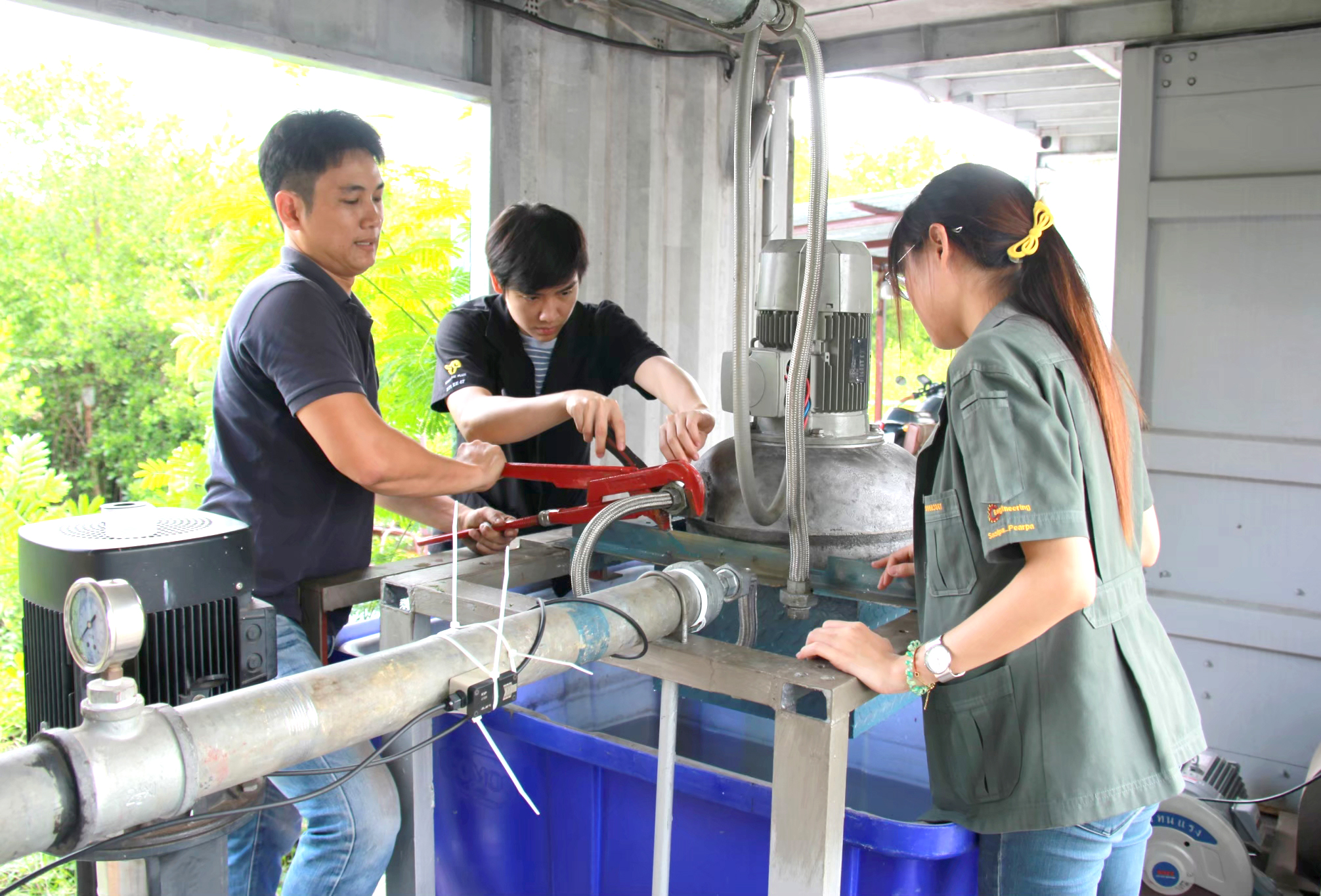การยกระดับมาตรฐานกังหันน้ำคีรีวง จังหวัดนครศรีธรรมราช โดยกระบวนการมีส่วนร่วม
Main Article Content
บทคัดย่อ
วิสาหกิจชุมชนกังหันน้ำคีรีวง ตำบลกำโลน อำเภอลานสกา จังหวัดนครศรีธรรมราช เป็นกลุ่มชาวบ้านที่พัฒนากังหันน้ำผลิตไฟฟ้าขนาด 0.3 -1 kW ปัจจุบันมีการติดตั้งกังหันน้ำผลิตไฟฟ้าในตำบลกำโลนและพื้นที่ชุมชนรอบเทือกเขานครศรีธรรมราช 160 ระบบ แต่ยังไม่มีการใช้งานในวงกว้าง เนื่องจากเป็นผลิตภัณฑ์ที่ตอบโจทย์เฉพาะพื้นที่ งานวิจัยนี้มีเป้าหมายเพื่อพัฒนาและยกระดับมาตรฐานกังหันน้ำคีรีวงสู่นวัตกรรมทั่วถึง โดยอาศัยกระบวนการมีส่วนของวิสาหกิจชุมชนกังหันน้ำคีรีวง กลุ่มผู้ใช้กังหันน้ำคีรีวง สถาบันการศึกษาและหน่วยงานภาครัฐในพื้นที่ รวมถึงประชาชนทั่วไป ด้วยการดำเนินการดังนี้ 1) การทดสอบกังหันน้ำคีรีวงเดิมภายใต้มาตรฐานที่เกี่ยวข้อง 2) การวิเคราะห์จุดเด่น/จุดด้อย จากผลการทดสอบกังหันน้ำคีรีวงเดิม 3) การขยายกำลังการผลิตกังหันน้ำคีรีวงเดิมเป็น 3 kW 4) การพัฒนากระบวนการผลิตกังหันน้ำคีรีวง 5) การถ่ายทอดเทคโนโลยี ผ่านการติดตั้งทดสอบที่บ้านคีรีวง จังหวัดนครศรีธรรมราช 6) การศึกษาผลตอบแทนในการลงทุน และ 7) การพัฒนาศักยภาพวิสาหกิจชุมชนกังหันน้ำคีรีวง ส่งผลให้เกิดต้นแบบกังหันน้ำคีรีวง รุ่น KRW-3000 (3 kW) ซึ่งสามารถผลิตไฟฟ้าได้เพิ่มขึ้น 3 เท่า ประสิทธิภาพเพิ่มขึ้นร้อยละ 20 ระยะเวลาคืนทุน 1 ปี เมื่อเปรียบเทียบกับเครื่องปั่นไฟหรือ 4 ปี 4 เดือน หากซื้อไฟฟ้าจากการไฟฟ้าส่วนภูมิภาค อัตราค่าไฟฟ้าที่ผลิตได้จากกังหันน้ำคีรีวง รุ่น KRW-3000 0.26 บาท/kWh ส่งผลให้วิสาหกิจชุมชนกังหันน้ำคีรีวงมีศักยภาพทางการตลาดเพิ่มขึ้น โดยมีรายรับเพิ่มขึ้นกว่า 5 แสนบาท ชาวบ้านมีทางเลือกในการใช้งานเทคโนโลยีการผลิตไฟฟ้า ลดค่าใช้จ่ายในการจัดหาเชื้อเพลิง มีความมั่นคงทางครอบครัวและสังคมท้องถิ่นและชุมชนมีความเป็นอยู่ที่ดีขึ้น
Article Details

อนุญาตภายใต้เงื่อนไข Creative Commons Attribution-NonCommercial-NoDerivatives 4.0 International License.
Area Based Development Research Journal values copyright protection and licensing to safeguard author rights and facilitate the appropriate dissemination of research. Our policies ensure openness, accessibility, and attribution. Authors retain copyright ownership, and articles are published under a Creative Commons Attribution License (CC BY), allowing sharing, adaptation, and proper attribution. Authors have the freedom to publish under the CC BY license, granting broad reuse and distribution permissions. The journal supports posting articles on third-party repositories, adhering to institutional and funding restrictions. Author guidelines detail copyright and licensing requirements, empowering authors with knowledge about their rights and responsibilities. These policies cultivate an environment of collaboration, openness, and responsible sharing, benefiting authors and the research community while honoring intellectual property rights.
เอกสารอ้างอิง
Anukun, M. (2023). Guidelines for developing tie-dye occupation group competitive advantages using a business model. Journal of Management Science Review, 25(1), 235–246. (in Thai).
Basar, M. F., Sapiee, R., Rahman, S., Hamdan, Z., Borhan, S., & Sopian, K. (2014). Cost analysis of pico hydro turbine for power
production. Advances in Environmental Biology, 8(14), 147–151.
Boonbumroong, U. (2012). Kiriwong hydropower unit: Local innovation to a micro community enterprise. Area Based Development Research Journal, 4(4), 66–75. (in Thai).
Boonsong, T., Junkong, R., Bunchoo, T., & Plodchookaew, K. (2022). Development and finding efficiency of water tunnel generator. Institute of Vocational Education Southern Region 1 Journal, 7(1), 101–107. (in Thai).
Chaichan, W., Kanchana, S., & Chaichan, W. (2019). Prototype of shallow-water wave power generator based on bi-directional
waves conversion. RMUTSV Research Journal, 11(2), 312–323. (in Thai).
Chumyim, P. (2024). Business model canvas: Tool to communicate your strategy. Retrieved May 20, 2024, from: https://Pmuc.
or.Th/Wp-Content/Uploads/2024/03/PMUC_Masterclasspart1_BMC_PC.Pdf. (in Thai).
Elbatran, A. H., Yaakob, O. B., Ahmed, Y. M., & Shabara, H. M. (2015). Operation, performance and economic analysis of low
head micro-hydropower turbines for rural and remote areas: A review. Renewable and Sustainable Energy Reviews, 43,
–50.
Gallego, E., Rubio-Clemente, A., Pineda, J., Velásquez, L., & Chica, E. (2021). Experimental analysis on the performance of a
pico-hydro Turgo turbine. Journal of King Saud University - Engineering Sciences, 33(4), 266–275.
Hayibaka, M., Waeberaheng, A., Saniso, E., Jirarattanatsopa, B., & Techo, J. (2021). Computational fluid dynamic analysis of flow through a Kaplan turbine for a small hydropower plant. Journal of Renewable Energy for Community, 4(2), 41–49.
Hydrology Division - Royal Irrigation Department. (2023). Rainfall data. Retrieved May 20, 2024, from: http://water.rid.go.th/
hydrology/PORTAL/3-RAINFALL.html. (in Thai).
Kaewrattanasripho, P. (2022). Simulation of the generating electricity from water turbines using the LabVIEW. Journal of Applied Research on Science and Technology, 21(2), 117–125. (in Thai).
Lahamornchaiyakul, W. (2021). Mechanical system design and analysis of horizontal axis micro water turbine. UBU Engineering Journal, 14(1), 1–13. (in Thai).
Maher, P., & Smith, N. (2001). Pico hydro for village power a practical manual for schemes up to 5 kW in hilly areas. Retrieved
May 20, 2024, from: https://energypedia.info/images/9/92/Ph_manual_s.pdf.
Mungkalasiri, W., Pidtalapho, S., & Mungkalasiri, J. (2018). Design of Archimedes screw turbines for small hydro power plant
case study of Namman small hydro power plant. Thai Science and Technology Journal, 26(6), 1049–1061. (in Thai).
Musiget, J., & Jarernsiripornkul, S. (2022). Business model of KK cricket farm, Tharpa subdistrict, Maung district, Khon Kaen
province. Journal of Modern Learning Development, 7(1), 286–300. (in Thai).
National Statistical Office. (2023). Population and housing census statistics. Retrieved May 20, 2024, from: http://statbbi.nso.
go.th/staticreport/page/sector/th/01.aspx. (in Thai).
Papamo, K., & Suntivarakorn, R. (2020). A study of the total efficiency of electricity generation system from vortex turbine by
crossflow hydro-turbine. Udon Thani Rajabhat University Journal of Sciences and Technology, 8(2), 159–173. (in Thai).
Pailin, T., & Ratchaphon, S. (2020). Optimization of turbine blade stature in free vortex system for power generation. Udon Thani Rajabhat University Journal of Sciences and Technology, 8(2), 175–186. (in Thai).
Phunphon, T., Yongphet, P., & Nakpibal, P. (2023). Design thinking for participatory organic farming community product
development. Research Journal Phranakhon Rajabhat: Social Sciences and Humanity, 18(1), 255–275. (in Thai).
Saomun, T., & Jarensiripornkul, S. (2024). Business model design of Kaset Chang Lim store on online platforms. MBA-KKU
Journal, 17(1), 27–48. (in Thai).
Sarabhon, P., Pong-a-mas, S., Somkeattikul, K., Siripaiboon, C., Areeprasert, C., & Kiatiwat. T. (2019). Prototyping of agricultural purpose vertical water turbine generator with adjustable blade for small cannel. Thai Society of Agricultural Engineering Journal, 25(2), 1–6. (in Thai).
Suriyasarn, T., Thitiyapramote, N., Khamrach, C., & Langkhunsaen, S. (2022). Product development of germinated brown
rice berry juice for health organic agriculture Wor-Kaew community enterprise group, Lampang province. Area Based
Development Research Journal, 14(2), 122–133. (in Thai).
Techo, J., & Pinthong, T. (2020). Analysis of hydroelectricity generation efficiency by vertical axis turbine at Takhian Luean
sub-district, Nakhon Sawan province. Journal of Industrial Technology Ubon Ratchathani Rajabhat University, 10(2), 99–112.
(in Thai).
Thailand Greenhouse Gas Management Organization (Public Organization). Local GOV save earth. Retrieved May 20, 2024, from: https://www.tgo.or.th/2023/index.php/th/page/publication-650/?p=2. (in Thai).
Thiwaworachai, M., & Chaichana, T. (2021). The study of suitable water flow control valve for power generation of micro power plant by CFD. Academic Journal: Uttaradit Rajabhat University, 16(2), 77–90. (in Thai).
Williams, A. A., & Simpson, R. (2009). Pico hydro-reducing technical risks for rural electrification. Renewable Energy, 34(8),
–1991.
Wiroon, M., Ratchaphon, S., Jarinee, J., & Ponthep., V. (2022). Efficiency comparison of horizontal low head spiral turbine for
electrical energy production. RMUTI Journal Science and Technology, 15(1), 48–58. (in Thai).


